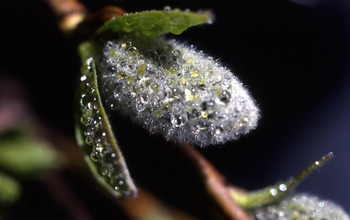Discovery
Earth Week: Whither Yellowstone’s willows and the streams they shade?
Yellowstone’s water table dropping below riverbank willow trees
|
Willow catkin with dew in Yellowstone. Willows there and elsewhere depend upon a supply of water. |
April 22, 2014
This article is the eighth in a series on NSF’s Long Term Research in Environmental Biology (LTREB) awards. Visit parts one, two, three, four, five, six, and seven.
Willows and streams. In Yellowstone, where there’s one, the other isn’t far behind.
On Earth Week, scientists are asking: How far do such connections reach?
New research on water-dependent willows shows that streams and willows may be conducting the music on Yellowstone’s ecological dance floor.
Ecologists Tom Hobbs, Kristin Marshall and David Cooper published the results in a recent issue of the Journal of Ecology. Hobbs and Cooper are with Colorado State University (CSU) in Fort Collins, Marshall is at NOAA.
After wolves were extirpated from Yellowstone almost 100 years ago, elk multiplied, says Hobbs. The herbivores roamed across the landscape, nibbling willows to nubbins.
But the story doesn’t end there.
With fewer willows to gnaw on, beavers began to decline. Crucially for willows, without the dams beavers build, which slow the flow of water, streams ran faster. Brooks soon became deeply carved into their banks from the force of rapidly-moving water.
Before long, the water table fell below the reach of streamside willows’ roots.
Wolves and elk, beavers and willows: carefully choreographed parts
“All the possible interactions among plants and animals in nature are impossible to separately identify and measure,” says Henry Gholz, program director in the National Science Foundation’s (NSF) Division of Environmental Biology, which funds the Yellowstone willow research through its Long Term Research in Environmental Biology (LTREB) Program.
“Yet scientists know these links are critical to the maintenance of functional ecosystems.”
Over a 30-year-period, Hobbs and colleagues studied riparian willow (Salix spp.) establishment and stem growth. In Yellowstone’s northern range, the scientists reconstructed willows’ history from tree rings. The three-decade time-frame covered the reintroduction of wolves in 1995.
“What happens to willows is shaped more by how high the water table is,” says Hobbs, “than by any other factor.”
The finding shows how complicated ecosystem links can be, says Gholz. “The effects of elk browsing on streamside willows in Yellowstone over the past 30 years are related more to variations in year-to-year climate, age of the willow trees, and changes in streams due to declining numbers of beavers.”
The scientists used climate variables such as annual precipitation, stream flow and growing season length; the abundance of herbivores (elk); and landscape elevation and an index of “topographic wetness” (how soggy the ground is) to predict willow growth before and after the reintroduction of wolves.
“Explaining variability in [willow] establishment required models with stream flow, annual precipitation and elk abundance,” write the ecologists in their paper.
“The results show that changes in the growth of willows after the reintroduction of wolves,” says Marshall, “can’t be understood without considering all the variables.”
Life as a willow: water required
Picture a willow as it leans over a river or stream. Willows, sallows and osiers form the genus Salix, made up of some 400 species of deciduous trees and shrubs. All are found on moist soils in cold and temperate regions of the Northern Hemisphere.
Most are known as willows, but some narrow-leaved shrub species are called osiers, and broader-leaved species are referred to as sallows, from an Old English word derived from the Latin term salix.
Willows are the dominant riparian, or riverside, woody vegetation in Yellowstone and across the Rocky Mountains, according to Hobbs.
In Yellowstone, willows are found along rivers and streams, as well as near springs, seeps and anywhere water is available.
“As long as willows’ roots can reach groundwater,” says Hobbs, “the trees can survive–and withstand very high levels of browsing by elk. It all comes down to water.”
On Earth Week and every week, the dance of life needs all the partners
Restoring an ecologically complete ecosystem in Yellowstone requires the return of willows–and with them, beavers, says Hobbs.
Once willows have returned, beavers will gnaw down a certain number of the trees to build dams. The dams will slow stream flow, allowing yet more willows to grow.
Willows, streams and beavers; wolves and elk. Willows and streams may have the first dance. But without them all, Yellowstone’s ecological music will eventually fade away.
| — | Cheryl Dybas, NSF (703) 292-7734 cdybas@nsf.gov |
Investigators
Fred Watson
David Cooper
Jennifer Hoeting
Matthew Kauffman
N. Thompson Hobbs
Related Institutions/Organizations
Colorado State University
Related Awards
#1147369 LTREB: Understanding controls on state-tranisition on Yellowstone’s northern range
Total Grants
$449,978
Related Websites
NSF Discoveries in Long-Term Ecological Research: http://www.nsf.gov/pubs/2013/nsf13083/nsf13083.pdf
Earth Week: The Search for White Gold – Snowmelt: http://www.nsf.gov/discoveries/disc_summ.jsp?cntn_id=127580
Earth Day: Big Ecosystem Changes Viewed Through the Lens of Tiny Carnivorous Plants: http://www.nsf.gov/news/news_summ.jsp?cntn_id=127651
Earth Week: A Stream Is a Stream Is a Stream: Or Is It?: http://www.nsf.gov/discoveries/disc_summ.jsp?cntn_id=123855
On ‘Earth Week,’ World Is No Longer Our Oyster: http://www.nsf.gov/news/news_summ.jsp?cntn_id=116767
It’s Earth Week. Just In Time, Thousands of Hectares of Tropical Forest Are Saved: http://www.nsf.gov/news/news_summ.jsp?cntn_id=119179
Earth Day in the future: What will it be like?: http://www.nsf.gov/discoveries/disc_summ.jsp?cntn_id=130998&org=NSF
Earth Week: Bark beetles change Rocky Mountain stream flows, affect water quality: http://www.nsf.gov/discoveries/disc_summ.jsp?cntn_id=130951&org=NSF
![]()
